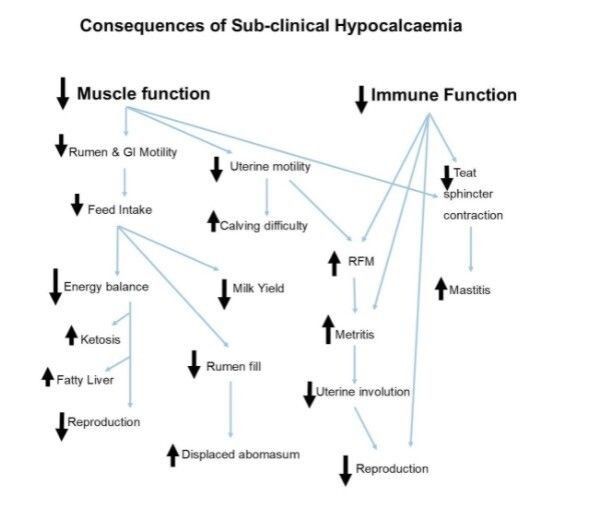Calcium and the Newly Calved Cow
In the period shortly before calving, large amounts of calcium are removed from the blood to be part of the colostrum. Calcium levels in colostrum may be eight to ten times greater than in the blood supply. This rapid drop of calcium in the blood and the failure of calcium absorption to increase fast enough after the onset of lactation, leads to transient periods of hypocalcaemia in all cows, including heifers. While very few cows actually get clinical hypocalcaemia (milk fever), the impact of subclinical hypocalcaemia can be more serious for your herd.

Clinical Milk Fever
Clinical milk fever is divided into 3 stages.
Stage I milk fever often goes unobserved because of its short duration (< 1 hour). Signs observed during this stage include loss of appetite, excitability, nervousness, hypersensitivity, weakness, weight shifting, and shuffling of the hind feet.
Stage II milk fever can last from 1 to 12 hours. The animal appears dull and listless; she has cold ears and a dry nose; she will likely be unable to stand, usually found lying in sternal recumbency. The affected animal may turn its head into its flank or may extend its head. Cows often have a characteristic “S-bend” in the neck. Constipation and a decrease in body temperature are also common.
Stage III milk fever is characterized by the animal's inability to stay sitting up, the cow lays out flat, often bloated and a progressive loss of consciousness leads to a coma. Cows in stage III will not survive for more than a few hours without treatment.
Treatment of clinical milk fever involves administering a calcium product into the vein of the cow. Cows treated for clinical milk fever should always receive an oral calcium supplement as well, but only when they are able to swallow.
Preventative Calcium Supplements
Oral calcium supplements around calving can help reduce the risk of subclinical hypocalcaemia as well as clinical cases of milk fever. There are various options available, with some being more beneficial than others. Oral liquids are generally fast acting but do not have a prolonged action, except for Bovisal Pearls, which has 4 types of calcium. Bovisal also has a good dose of phosphorus in it. The big risk with liquid & gel products is the risk of accidental inhalation if cows are not swallowing, struggle during administration or the product is forced down the cows throat.
A safer option are the oral boluses such as the TransitionTM bolus, which can quickly elevate calcium levels in the blood, while also providing a prolonged supply of calcium to the cow. These should be given to cows most at risk of developing hypocalcaemia in your herd, especially cows that have had previous history of milk fever, older cows, lame cows, high producers, cows that are fat (>5.5 BCS). In higher performing herds you may like to consider treating all the 2nd lactation cows and older.

Oral boluses should be used in conjunction with other forms of calcium supplement such as limeflour in the meal or maize or dusted onto the pasture of the colostrum cows. The bolus will correct the immediate deficiency at calving allowing the cow time to ingest other feeds that contain the calcium supplements, thus ensuring that she gets sufficient calcium in early lactation to minimise the risks outlined above.
Other management options to help reduce the risk of hypocalcaemia include ensuring adequate magnesium supplementation to all cows, once daily milking during the colostrum period and for any sick and depressed (SAD) cows, energy supplements such as MPG or starter drench for SAD cows and using B12 injections to stimulate appetite in freshly calved cows. It is also important to ensure adequate levels of trace elements like selenium, copper & zinc are present to support immune function.